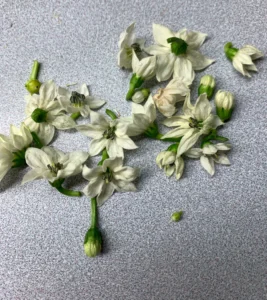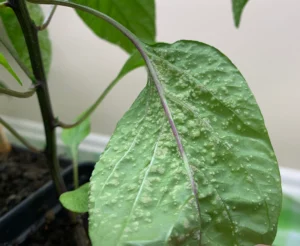What to do when your seedlings grow too big
Thanks to the University of Maryland/Maryland Grows this informative article on what to do when your seedlings grow too big
I started my peppers too early.
Every year I warn fellow gardeners not to rush on getting seeds into pots for warm-weather vegetables. Tomatoes, in particular, outgrow their indoor space under lights much faster than you’d think. However, you can make this mistake with many plants that shouldn’t go outdoors until the chance of frost is past and the soil temperature is at least 60 degrees F. There’s often a several-week gap between the average-last-frost day that you used to count back from when calculating start dates and the actual day that it’s safe to put the plants in the garden. That can go either way, of course. Unless you’re inclined toward taking risks, it’s better to err on the side of later planting. The seedlings will grow faster under warm conditions and catch up with their early-planted peers.
So, there was no reason to put the pepper seeds in as early as the very end of February, but I did it anyway. We all have those moments. Mid-March would have been fine. But, I know I was feeling anxious about other things and probably projected those feelings onto my peppers. And now I have some large strong well-grown pepper plants that are more than ready to go into the ground–which some of them are going to do this week, soil temperatures notwithstanding.

If you have been in this situation, which most of us seed-starters have, here are some things you can do, more or less in chronological order. This applies also to plants you may have bought a while before you could plant them–we all do that too!
- Pot up. If your plants have been growing for some weeks and are starting to show signs of stress, they may need to be transferred to larger pots. More room for the roots = more time until they need to go into the garden. Unfortunately, larger pots usually require more horizontal space under lights, so this is a dance that can’t go on forever as your seedlings grow too big.
- Fertilize. I recommend this step after potting up. It doesn’t help stressed plants that have no room to grow to be fed and encouraged to put out more stems and leaves and roots. Potting up will involve adding some fresh potting soil, which may include fertilizer (check the label). After a couple more weeks, though, you may need to add some fertilizer when you water. This is especially true if you see any evidence of nutrient deficiency, such as yellowing of the leaves between the veins. Follow the directions, and remember that less is more with seedlings; better to halve the fertilizer amount and use it weekly than shock the plants with too much. A balanced fertilizer is fine, or one with more nitrogen than the other elements. Take it easy on the phosphorus. It will encourage flowering that isn’t good for the plants at this stage (see below).
- Take off the flowers. Stressed plants will often go to flower in order to reproduce before they die; healthy plants want to move into the reproductive stage of their lives, but trying to make flowers, fruit and seeds will stress them if their roots are still confined in a small pot. If you can, remove the flowers as soon as they appear. Once the plant’s in the ground, let it go wild.
- Water when the soil starts to dry out. Don’t overwater; the pot should be large enough to hold moisture in the soil for a while. Overwatering can cause issues like mold, infestations of fungus gnats, and edema. Edema is swelling of plant tissue that looks like weird bumps on the leaves and causes panic in the gardener–no worries, it will stop when you even out the watering.
- Watch out that the tops of the plants don’t hit the lights. You can burn your plants this way. What to do when you can’t raise the lights any higher? If it’s still really cold outside, find a window; if it’s warmed up, at least during the day, move the plants outside when the seedlings grow too big.
- Harden off the plants. Normally this process of exposing plants to outdoor conditions takes a week or less. You can always stretch it out for longer, though it can be a pain moving the trays in and out. Most warm-weather vegetables don’t like temperatures under 50 degrees F. or so, so do keep an eye out, but if it’s warmer than that, you can give them a few hours outside the first day and then increase the time until they are spending all their time outdoors (barring a sudden cold snap).
- Just go ahead and plant them. That’s what I’m going to end up doing pretty soon (maybe by the time you read this!). I’ll plant them on a warm day, water well, and be prepared to throw some floating row cover over them if the temperatures drop. Normally I wait to plant peppers until at least mid-May, but I’m sure they’ll be fine! Right??



Edema on a pepper leaf. No, it’s not a pest or disease!

We are so close to summer now! But if you have warm-weather plants already in your garden, keep an eye on the forecast and be ready to protect them if it gets cold again. If I’m lucky, I may get an early harvest of peppers, but next year, I’m not starting them until the middle of March.
By Erica Smith, Montgomery County Master Gardener. Read more posts by Erica.
If you are looking to buy or sell your home (with or without a garden), contact Gigi today. Oh by the way, I’m never too busy for any of your referrals!





Recent Comments